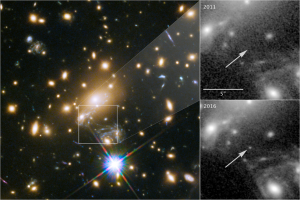Why outer space is the perfect setting for sci-fi [04-07-20]
It started with this TikTok:
which prompted a series of Google searches that eventually led me to the official NASA organization’s SoundCloud where I confirmed that there are a series of actual sounds captured by the US’ spacecraft instruments as they flew by planets/stars:
It turns out that planets’ atmospheres and environments make noise which cannot traverse the depths of space so are never heard by us on Earth. But these recordings give a glimpse (or I guess a listen) as to what we would hear, were we on these planets.
Equally as crazy is the fact that everything you look out to see in space is actually the past. Since light takes time to travel and reach our eyes, and distances between stars can be pretty significant (measured in light years, i.e. the distance traveled by light in a year), then we can start to make sense of images like the one shown down below:

Hubble Uncovers the Farthest Star Ever Seen [“…its light has taken 9 billion years to reach Earth”]
Imagine you were at a Blue Angels flight demonstration. You can hear the planes coming but sometimes it can be tricky to spot where they are coming from or where they currently are. Or you can think of when you hear lightning and see the lightning strike but the two events are disconnected in time (staggered so that one reaches your senses first, then the other). This is because sound waves and light waves take different amounts of time to travel. For the flight show example, you are probably seeing the place where the planes were only seconds, or fractions of a second, ago. But for larger distances, like the stars seen by the Hubble telescope, we are actually looking at what the star or galaxy was doing hundreds or even up to thousands of years ago. You are looking back in time.
With all these strange and unique properties, which are still mind-blowing when you think about them explicitly, it is no surprise that space is a popular setting for sci-fi stories. After all, it already features talking planets and lets us play with notions of time.
___________________________________________________________________________________________________
Tik Tok– Nasjaq_(02-12-20)
Nasjaq_ (Jack) is a chemical engineer turned investor who makes content that explains tech and other news in a way that is super accessible. In addition to unpacking new findings, he often provides his own suggestions and interpretations for how this tech can be used in the future. He has had videos on the topics of augmented reality, nanotechnology, and other relevant content. This is a source of raw (accurate) data on the latest and greatest innovations. Great resource for anyone looking for topics to play around with when developing an SF world.
Link to Nasjaq’s page: https://vm.tiktok.com/qD7cgK/
Topics recently covered:

[https://www.geekwire.com/2019/spacex-fcc-starlink-million-earth-stations/]

[https://blog.bigimmersive.com/calm-before-the-storm/]
